Since the outbreak of COVID-19, we have been hearing a lot about face masks, N95 masks, and Appendix A. From a nationwide shortage of masks, to the latest CDC recommendation encouraging people to wear masks in public settings, its clear masks are at the forefront on everyone’s minds. But what do we really know about the difference of these types of face masks between health care workers and the rest of us? See: frequently asked questions and answers to help explain the use of masks during the COVID-19 pandemic.
I have been hearing a lot about N95 masks. What does this mask do that is different from others?
Answer: N95 masks, or N95 respirators, are a type of personal protective equipment (PPE) used most by healthcare workers who need a higher level of protection. These masks are tighter-fitting and made of higher filtration material than regular masks so that they can filter out an estimated 95% of airborne particles that might otherwise pose a threat to an individual’s health.
The Centers for Disease Control and Prevention (CDC) does not recommend that the public wear N95 respirators to protect themselves. N95s are intended only for healthcare professionals who need protection from airborne hazards when tending to patients. Examples of who might need this type of mask would include healthcare workers who do procedures that put germs into the air – especially healthcare workers who work with patients on ventilators and other invasive procedures. N95 masks are NIOSH approved. N95s are intended only for healthcare professionals who need protection from airborne hazards when tending to patients.
Examples of who might need this type of mask would include healthcare workers who do procedures that put germs into the air – especially healthcare workers who work with patients on ventilators and other invasive procedures. These masks fit tightly to the face and have the highest filtration efficiency, blocking 95 percent of particles of 0.3 microns or larger. An N95 mask protects medical workers who encounter high doses of the virus while visiting and carrying out medical procedures on multiple patients. The rest of us don’t need that level of protection, so these masks should be reserved for health care workers only.
I have been hearing a lot about the need to purchase KN95 and N95 masks off Appendix A. Rumor has it any manufacturer not on Appendix A is a fake. I have heard Appendix A is a list FDA published so it should mean they are the only quality mask manufacturers available, right?
Answer: False, Appendix A is not intended to grade all mask manufactures. Appendix A was created because of a national shortage of NIOSH approved N95 masks for the medical industry. FDA needed a way to put urgent PPE equipment in the hands of frontline healthcare workers. Previously, the FDA required N95 masks to be both FDA 510k certified (a test proving the mask meeting surgical mask requirements), and NIOSH certified. During COVID-19 the FDA relaxed these requirements to bypass the FDA import clearance process.
They removed the requirement for FDA 510k and NIOSH and added KN95 masks as an authorized alternative to the N95 masks. Importers simply need to sign a EUA (Emergency Use Authorization) form proving they are being delivered straight to medical workers. There have been cases where this EUA form was used to import medical products and when the filtration was tested it tested well below the 95% filtration N95 threshold (as low as 28%)!
In fact Avery’s client purchased from Appendix A and tested the masks and they failed, proving Appendix A is only a move FDA made in order to put PPE in the hands of healthcare workers quickly and it is not guaranteed to be N95 quality. As an example, the supplier “Chengde Technology” listed on Appendix A (https://www.fda.gov/media/136663/download), shows they supply a “PM 2.5” filter mask. The PM 2.5 filter is a very simple filter designed for environmental allergens, like a HEPA filter. Chengde Technology is also not registered as an authorized medical mask manufacturer or exporter in China.
Chengde are only authorized to export civilian masks, so the Appendix A is deceiving. Due to the number of fake masks being exported from China, the Chinese government put a crackdown on masks and any mask manufacturers that opened after February 2020 are not authorized to produce or export medical grade masks. Many of the suppliers listed on Appendix A were opened in 2020 and many are not authorized to produce medical grade masks.
What is the most important thing to know when purchasing masks for non-medical use?
ANSWER: Filtration. ID&C’s filtration levels are at 99% filtration, compared to the 95% filtration requirement for N95 masks. ID&C purchased a filtration test machine and test every lot of material. The main component that makes a mask have a high filtration level is the “melt blown fabric”. There are suppliers who purchase cheap melt blown fabric and state it is 99% filtration. ID&C and our mask manufacturer entered a legal agreement requiring proven test results. ID&C had CCL’s head of China employee visit the factory and review the filtration testing machine, materials, and results himself.
BFE (Bacterial Filtration Efficiency) melt blow material trades at $37,000 a ton for 99% filtration, $25,000 a ton for 95% filtration, and $4,200 a ton for 90% filtration, no wonder manufactures cheat and buy cheap material! ID&C and our KN95 mask manufacturer only purchase BFE95%-99% melt blown material and our manufacturer is legally bound by our agreement to do so. Our manufacture is required to test every lot and show us the results prior to production.
COVID-19 spreads mainly from person to person through respiratory droplets produced when an infected person coughs, sneezes, or talks. These droplets can land in the mouths or noses of people who are nearby or possibly be inhaled into the lungs. Studies indicate these droplets usually travel around 6 feet (about two arms lengths). That is why the combination of a high filtration mask and social distancing is important. ID&C’s KN95 masks have certified test results that meet the following standards: CE Certified, EN 149:2001+A1:2009, FFP2, GB2626-2006, KN95 yet test at 99% filtration levels. ID&C’s 3 ply masks meet YY/T0969, CE standards, yet test at 99% filtration levels.
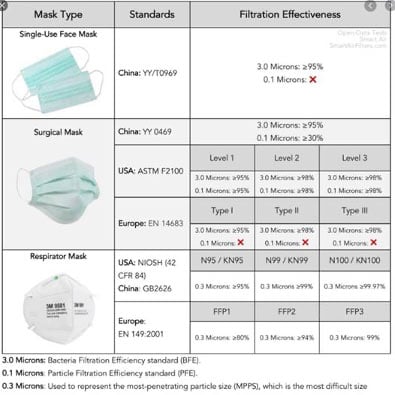
What are ASTM Levels 1-3?
ANSWER: ASTM Levels distinguish the type of mask needed in a medical setting. ASTM is the preferred national standard in the healthcare industry. The FDA, who oversees the sale and marketing of surgical masks, recommends that manufacturers demonstrate mask performance in four areas: Fluid Resistance, Breathability, Filtration, and Flammability. ID&C can secure ASTM level masks; however, the minimums are 100,000 pcs – 1 million pcs and the production time is a lot longer and the masks are a lot more expensive. In fact, during COVID-19 ID&C are not allowed to purchase medical or surgical grade masks and import them with an EUA form unless they are going directly to a medical facility. ASTM measurers 4 levels: Filtration, Breathability, Flammability, Fluid Resistance (to bodily fluids). Level 1 is medical, not sterile for exams, Level 2 is moderate barrier, Level 3 is maximum barrel (sterile) for surgical settings. ASTM masks are not necessary in a general everyday setting. Remember, filtration is key!
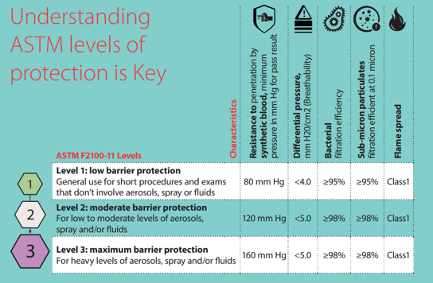
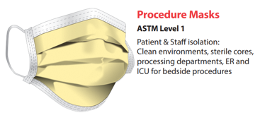
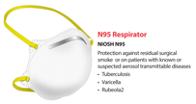
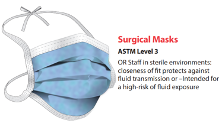
What about medical masks?
ANSWER: Medical masks reduce the transfer of saliva and respiratory droplets to others and help block blood and other potentially infectious materials from the skin, mouth, or nose of the wearer. Medical masks may or may not have some level of fluid-resistance and do not seal tightly to the wearer’s face (NIOSH N95 do). They have multiple layers of different non-woven fabric materials, which are fused together. N95's are available in different thicknesses and with different ability to protect from contact with splashes and droplets. Medical masks are designed for single-use and will deteriorate with prolonged use, exposure to moisture and exposure to standard levels of disinfection such as chemicals, heat, and radiation. These are also in short supply and should only be used only by medical workers. Medical masks are made of a paper-like non-woven material and are often given to a coughing patient waiting to see a doctor. Compared to the N95 or KN95 mask, a medical mask filters about 60 to 80 percent of particles and, according to the Food and Drug Administration, mostly blocks “large-particle droplets, splashes, sprays or splatter that may contain germs.”
What about surgical masks?
ANSWER: In addition to N95 masks, there are also surgical or “procedure” masks. These masks are made in different thicknesses and have ability to protect healthcare workers from contact with splashes. A surgical mask is the type you are used to seeing on TV surgeons and are usually rectangle shaped. Surgical masks have a special additional “sterile” coating on the material that medical masks do not have.
What are NIOSH and FFP standards?
ANSWER: “NIOSH” is the USA’s and “FFP” is the European’s method for testing the way a mask fits snugly to a person’s face. NIOSH/FFP measure how much particles can enter/escape through the edges of the worn face mask. Since 3 ply masks do not fit snugly on the face, they are not rated using NIOSH/FFP standards. ID&C’s KN95 are certified with the Europeans FFP2 rating which is equivalent to the USA’s NIOSH N95/KN95 standard. However, ID&C has not undergone USA’s NIOSH testing as the process is extremely expensive and comprehensive.
I am not a healthcare worker. Do I need a face mask? If so, what kind do I need and when am I expected to wear it?
ANSWER: According to CDC recommendations, the general public is strongly encouraged to wear face masks in public settings where social distancing is difficult to maintain (i.e. - grocery stores, pharmacies, music concerts, sport events, hotels, and theme parks). There are many kinds of masks – and most are just fine. The important thing is to have a thick enough material that can better block germ particles. Layers of fabric can help with this. Masks should only be worn if developmentally appropriate and if tolerated. The CDC says not to put a mask on young children under age 2.
Do I need to wear a mask everywhere?
ANSWER: The Centers for Disease Control and Prevention recommends almost everyone wear a face covering, or mask, in public places like grocery stores, pharmacies and other places where it is hard to stay 6 feet apart from other people.
Will a civilian mask protect me?
ANSWER: The main reason for wearing a mask is to protect other people. If you are wearing a mask over your mouth and nose and you cough or sneeze, the mask can catch respiratory droplets and keep them from landing on other people. If you are wearing a mask and someone next to you coughs or sneezes, their respiratory droplets would hit your mask instead of your mouth! But it is very important for you to not touch the front of your mask. And if you do forget and touch the front of your mask, just make sure you wash your hands right away. The masks also keep you from inadvertently touching your mouth or nose with unwashed hands.
How can I make wearing a mask more comfortable?
ANSWER: Wearing a mask is not something most of us are used to doing. Make sure you are doing it correctly so that you get the best protection. Some people are finding they need to modify the straps or loops with clips and other items behind their head, such as ID&C’s ear savers! This is all fine – if it fits securely over your nose and mouth, and if you can still breathe! Remember – this means you should not slip your mask off your nose, or down around your chin. To work, the mask needs to cover your nose and mouth.
Just as important — when wearing the mask, try not to touch it. When you must touch it – to remove it, for example – wash your hands with soap and water after. And, if you are using a cloth mask, make sure you’re washing the mask after a few wears so it stays clean.
What type of filter is inside the reusable and washable fabric cloth face mask?
ANSWER:
PM 2.5 Carbon filters are used in air purifiers to absorb, remove, and capture particulate in the air. Airborne particulates react chemically with the carbon in the filter, causing it to stick to the filter. Carbon filters are used to trap allergens like dust, mold, smoke, and chemicals in the air. Face masks sporting carbon filters come with optional replaceable filters that helps remove bacteria from the air and, additionally, helps absorb particulate on the surface of the mask. The Centers for Disease Control and Prevention recommends we cover our faces with a mask, scarf, or bandana when we are in public. Be sure to follow the CDC’s recommendation for wearing, removing, and washing cloth masks (and bandanas).







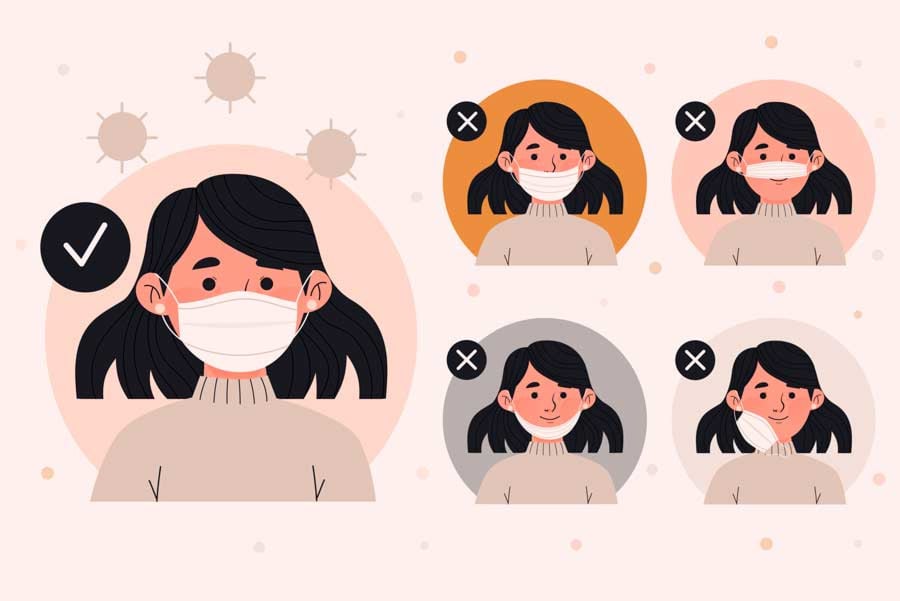
Login and Registration Form